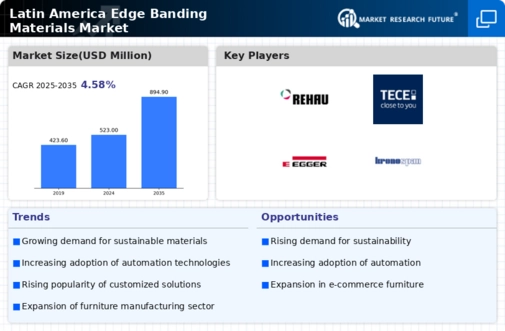The competitive landscape of the LATAM edge banding materials market is dynamic and multifaceted, featuring a blend of multinational giants and prominent regional players. Multinational company such as Rehau dominate the market with their extensive portfolios and global expertise, offering a range of edge banding solutions including PVC, ABS, and acrylic materials. Their robust distribution networks and innovation drive their strong presence in the region. The market also sees competition from specialized firm like Häfele, which provide high-quality, niche edge banding solutions and benefit from their technological advancements and focus on sustainability.
The growing trend towards customized and eco-friendly products is reshaping the market, compelling companies to innovate continuously. Economic fluctuations and varying regulatory environments across LATAM further influence market dynamics, with players adjusting their strategies to address these challenges. As a result, the market is characterized by a high level of competition, with companies vying to differentiate themselves through product quality, customer service, and strategic partnerships.
In the LATAM edge banding market, companies employ several strategic approaches to gain a competitive edge. They focus on diversifying their product offerings to cater to different segments of the market, from budget-friendly options to high-end solutions. Innovation plays a crucial role, with firms investing in advanced technologies and materials to improve durability, aesthetic appeal, and ease of application. Strategic partnerships and collaborations with local distributors and manufacturers enhance market reach and customer service. Additionally, companies are increasingly adopting sustainable practices to appeal to environmentally conscious consumers and comply with regional regulations.
Tailoring marketing strategies to local preferences and industry needs also helps companies strengthen their market presence and brand loyalty.
REHAU Group: The REHAU Group is a family-owned polymer business, which develops, manufactures and markets products for the automotive, construction, furniture, materials, medical and industrial sectors. Rehau employs more than 20,000 people in over 190 locations. Established by entreprenuer Helmut Wagner in the town of Rehau, Bavaria, the company has become a major player in the global construction and the associated industries with it, including furniture, interior design and others.
The company produces components for the automotive industry such as Interior and Exterior Components, Window and Door Systems, Heating and Cooling Systems and others for Building & Construction Industry and others. The headquarters for the car and industry business is in Rehau (Bavaria) and for Commercial Construction is in Erlangen (Bavaria). The administrative headquarters of the REHAU Group is located in Muri bei Bern, Switzerland (canton of Bern).
TECE: TECE, a prominent edge banding manufacturer, specializes in providing high-quality solutions for the furniture industry worldwide. Renowned for innovation and reliability, started with a small workshop in Bursa-Turkey with production of only veneer, TECE today produces a wide range of edge banding products in paper, plastic and more. From a 100m2 workshop in the suburb of Bursa to a 30,000 square meter factory; through the course of last quarter century, TECE has been growing steadily. TECE is the only company in the world to produce ABS, PVC, melamine, PMMA, metal and veneer edge banding under one roof.
With a focus on sustainability and customer satisfaction, TECE leverages advanced manufacturing processes and cutting-edge technology to deliver premium edge banding solutions that meet the stringent demands of modern furniture manufacturing. Committed to excellence, TECE continues to be a trusted partner for furniture manufacturers seeking superior edge banding solutions around the world.















Leave a Comment